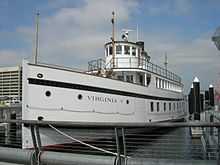Mosquito Fleet

The term Mosquito Fleet has had a variety of uses around the world.
United States
In U.S. naval and maritime history, the term has had nine main meanings:
- The United States Navy's fleet of small gunboats, leading up to and during the War of 1812, most were part of the New Orleans Squadron.
- A squadron of shallow-draft schooners sent to the West Indies under the command of Commodore David Porter to suppress piracy between 1823 and 1825, founding the West Indies Squadron.
- The name of a United States Navy "squadron detachment", commanded by Commodore Matthew C. Perry, that fought against the Mexican fortresses at Tuxpan and Villahermosa during the Mexican-American War.
- In the Civil War, it was the name of a group of converted gunboats originally of the North Carolina Navy, later transferred to the Confederate States Navy, that operated in and near the North Carolina Sounds from the start of the war until the Battle of Elizabeth City.
- In the Civil War, it was the name of Commodore George Hollins River defense fleet that opposed the Union Gulf Blockade fleet in the Battle of the Head of Passes.[1]
- A fleet of small steam vessels which plied the waters of Puget Sound during the late 19th century and early 20th century (see Washington State Ferries and Puget Sound Navigation Company). It was also used to describe the various steamboats and other small craft that served on the rivers and bays of the Oregon coast. (See Steamboats of the Oregon Coast). There was also a similar fleet on the east coast of the United States; see Sabino.
- A fleet of converted yachts used by the US Navy during World War I off the Atlantic Coast of France to patrol for U-boats and provide support for convoys into Brest, France. This fleet was also called the 'Suicide Fleet'.
- The fast, wooden PT boat used by the American navy in World War II. The most famous being PT-109, skippered by Lieutenant Junior Grade John F. Kennedy, a future president of the United States.
- The fleet of sailing ships that plied the waters off the coast of South Carolina and Georgia in the mid-19th century, trawling for shrimp and selling their catch in local markets; the fleet was primarily crewed by Gullah fishermen.
South Australia

The term "Mosquito Fleet" also refers the the fleet of small ketches and schooners operating in the shallow coastal and gulf waters of South Australia, from the colony's establishment in 1836 until 1982.
From the State's main port of Port Adelaide they supplied goods to many isolated regional settlements, returning with cargoes of agricultural products (particularly wheat and wool) and minerals. They also played a role in lightering grain to load larger vessels offshore in deeper waters, the most famous example being to windjammers off Port Victoria, Spencer Gulf, which until 1949 marked the start of the Great Grain Race.
Among the last surviving ketches are the 1883 Nelcebee (owned by the South Australian Maritime Museum) and the 1919-built Falie.[2]
Notes
- Abbreviations used in these notes
- Official atlas: Atlas to accompany the official records of the Union and Confederate armies.
- ORA (Official records, armies): War of the Rebellion: a compilation of the official records of the Union and Confederate Armies.
- ORN (Official records, navies): Official records of the Union and Confederate Navies in the War of the Rebellion.
References
- ↑ ORN I, v. 16, p. 725.
- ↑ South Australian Maritime Museum > The Mosquito Fleet - South Australia's Ketches Accessed 29 January 2014.
| |||||||||||